Tails, Tendons and Tripe: A Guide to Discovering the Odd Bits
 Put down your rib-eyes, don’t thaw those chicken legs just yet, and step away from the pot roast. Don’t get me wrong – those are fine examples of animal muscle meat. Delicious, even. But they’re not all that we should be eating. Not by a long shot. Allow me to explain.
Put down your rib-eyes, don’t thaw those chicken legs just yet, and step away from the pot roast. Don’t get me wrong – those are fine examples of animal muscle meat. Delicious, even. But they’re not all that we should be eating. Not by a long shot. Allow me to explain.
The other day, I received an enthusiastic email from a reader who’d just returned home from the grocery store with a sack of smoked turkey tails. Thanks to a little holiday called Thanksgiving, meat counters across the country are inundated with turkey parts: gizzards, livers, hearts, necks, backs, and tails. Most consumers rarely think of using turkey other than as a “healthy” replacement for ground beef or during Thanksgiving. But not our reader. No, he filled his freezer with smoked turkey tails and the whole experience apparently inspired him, because he wrote to tell me that maybe if I wrote a post extolling the benefits of all the “odd bits” of the animals you eat, other readers would also discover a whole new culinary world.
I know what you’re thinking, because I thought the same thing. I already make bone broth regularly and eat liver on occasion. And I may pick up some “strange” things if I come across them (say, a lamb kidney, or beef heart). I usually thoroughly enjoy it all, too. But offal isn’t usually at the top of my shopping list. If we truly want to eat nose to tail, though – and we should, you know – we have to branch out. We have to delve deeply. We have to get creative. Our wallets, our taste buds, and our bodies will thank us.
So I went out and spent a couple days hunting down odd parts at the farmers’ market, the Asian supermarket, and my other sources. Here’s what I found:
Heads

Ever since the Mad Cow Disease scare, heads of ruminants are hard to come by. I’ve asked many a farmer for a cow head on many an occasion, but I’ve always been rejected. It’s sad, but I guess I understand. Luckily, I managed to dig up a pastured goat head for a mere dollar per pound. This particular head ran me two bucks, and while its meat content is pretty scant when compared to a cow or pig head, it’s still a head, and that’s what I came for.
Goats aren’t geniuses, but they do have brains. Split open that head, scoop out the brain, and make like an ancestral hominid and cook it up. Okay, while our ancestors probably weren’t stir-frying their brain in garam masala and turmeric, they were eating it. Brain is a rich source of omega-3s, especially pastured brain, and it’s likely that landlocked hunter-gatherers satisfied some of their omega-3 requirements through brain. If you don’t want to bother splitting skulls, why not make some broth out of your head? Throw it in a pot, cover it with water, and toss in some spices, herbs, and a bit of vinegar. Turn it into head cheese (that’s what I’m doing) if you prefer, or just make some soup. Once the meat is tender enough, remove it from the skull to avoid overcooking.
I also picked up a couple fish heads – halibut and salmon. Three and a half pounds worth for $10. I’ve gotten these before, and my favorite thing to do is apply a light dusting of salt and pepper, rub some olive oil all over, and pop in the oven at around 350 degrees for just under twenty minutes. That’s enough to crisp the skin without drying out the meat or burning the fat. Once it’s done, go to town on it. The cheek is the best part, but use your hands to access the interior and keep a lot of napkins handy. You’re going to make a pretty big mess if you want to get everything. It should go without saying that these contain omega-3s, but there should also be a big dose of fat soluble vitamins, selenium, iodine, and other minerals found in ocean water. You could also make fish head soup, of course. If you want to make soup, have the heads cut at the butcher.
Feet
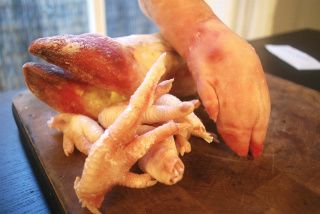
People find feet gross, for some reason. Maybe it’s the fact that they’re in constant contact with the ground, and the ground is definitely not sterile. I guess I see where they’re coming from, but I look at feet differently. I like the fact that feet are what the animal uses to get around, because that means the feet bear all the weight. And any body part that has to handle a lot of force – like the foot – tends to have a lot of collagen, cartilage, and other connective tissue to deal with all that stress. That’s why feet make the best stock. Chicken feet, pig feet, beef feet – they’re all incredibly gelatinous and when you cover them with water and apply heat for 24-48 hours, amazing stuff happens. There is very little meat, so soup/broth/stock is the best option here. Dim sum joints serve fried and braised chicken feet, so I suppose you could play around with that dish. Now that I think of it, a chicken foot braised to the point of disintegration would be really good.
I got pig, beef, and chicken feet for $0.99/lb, $1.29/lb, and $1.99/lb respectively. I’m going to make some stock so rich and so thick that you could sleep quite comfortably on a bed made of it. I suggest you do the same. I kept the beef and pig feet intact for the photo’s sake, but if you get any sort of large animal foot from the butcher, have them cut it up to make the stock-making easier.
Tails
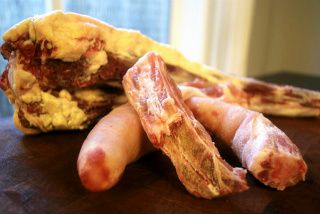
As you can see, the bison tail (which is very similar to beef oxtail, really) is meaty and massive, while the pig’s tail is quite small (and unfortunately not curly). Both are super-gelatinous and both make excellent broth. Both tails have a fair bit of meat on them, so I’d recommend a braise or a crockpot recipe where the meat is featured prominently. Don’t just treat the tails like broth bones. They’ll make a fine, rich stock, sure, but there’s also some good eating to be had. Cook ‘em long and slow and let them cool a little bit before you plunge in.
I picked up a box of pastured bison tails for $2.90 a pound and a few pork tails for a dollar per pound. The bison tails were whole, so I had to cut them up myself. Cutting a big bison tail without professional equipment requires getting in between the vertebrae. Use your fingers to find the joints and go from there.
Stomach
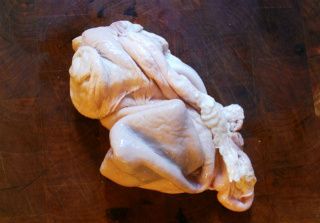
While your first inclination may be to retch at the idea of eating a pig’s stomach, I like to call it the Primal crockpot (or, alternately, the Foolproof Sausage Casing). It’s tender, rich, mild, and assumes other flavors really well. Most cooks usually use stomach as an encasing for ground up meat and vegetables. Since what stomachs do in the wild is hold food, it’s an obvious way to cook with it, but another option is to boil and chop it. You could eat the boiled stomach as is (or in soup), or you could dry it off, toss it in spices and fat, and roast/saute it until browned and crispy. I recommend something spicy and sour, maybe a cumin-chili-lime-olive oil spice mix, or even a turmeric-chili-vinegar-coconut oil one.
Stomach isn’t a nutritional powerhouse on par with liver or kidney – it’s mostly fat and protein with a nice dose of selenium – but it’s cheap, it’s tasty, and you can fill it up with other foods (think massive rotund sausage). I paid $1 per pound for mine.
Spleen
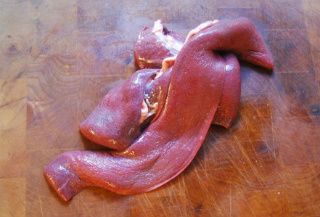
Spleen is sometimes called a poor man’s liver. It tastes a bit like it, but not as strong. It kinda looks like it, but not when you look closely. It’s high in iron, copper, selenium, and vitamin B12. It’s more delicate than liver with none of the retinol.
I got pork spleen, also called pork melt, for a couple bucks per pound.
Tendon
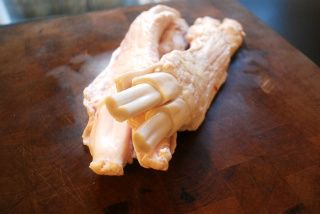
When most people want real broth, they turn to bones. I mean, bone broth is great. It’s alliterative, for one. It makes your house smell good (or terrible, depending on whom you ask), and it is filling on a cold day in a way that only meaty liquid can be. But if you’re a true rich broth fiend, if you’re a devout Ray Peat-ian, if you’re all about the gelatin – you had better go out and procure yourself some beef tendons. A tendon is a prime piece of connective tissue designed to hold muscle to bone and withstand all the crazy tension and force and stress that such a relationship inevitably entails. Thus, it is pure collagen, which means good things for your broth. Of course, it’s just collagen without the bone, so the broth won’t have that boney meatiness, but if you add a few bones to the mix you’ll get the best of both worlds. Tendons are basically fat-free, but a well-cooked tendon gives a mouthfeel similar to good pork belly. Good braised, good in soups.
Beef tendon ran $2.99 a pound. I got two large tendons for $4.
Tripe

Tripe is (usually beef) stomach lining. Of course, cows have several stomachs, so there are several types of tripe. I bought book tripe, which comes from the third compartment in a cow’s digestive system – the omasum. As you can see, it’s white, but that’s only because to prepare it for human consumption, tripe is thoroughly cleaned. Uncleaned tripe is intense stuff. Dogs love it, it smells like a barn, it’s green thanks to all the partially digested plant matter, and because it’s literally a cow’s gut, it’s a good source of probiotic bacteria. I almost wish it was palatable in its uncleaned state, because it’s supposed to be a nutritional powerhouse. Cleaned tripe is very mild. Its fibrous texture demands long, slow cooking and it goes well with spicy soups (a lot of tripe is used in Southeast Asian and Mexican cuisine). High in protein with a good amount of calcium.
A little over a pound of tripe cost me $3.75.
Blood
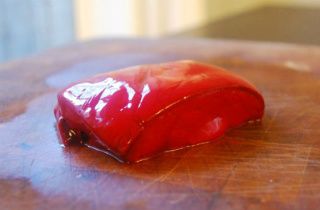
Blood is scary. Too much of it in the room at once means someone’s hurt, usually seriously. It’s red, really red. But countless cultures across history have used (and still use) blood in their cooking. Okay, so what does one do with blood? If you’re Maasai, maybe you drink it raw. If you’re an ancient Spartan, you make melas zomos, the “black soup.” If you’re a cured meat artisan, you’d probably make blood sausage. Cubed fully coagulated pork blood is often used in Southeast Asian cooking. One of my favorite soups from a local Hollywood Thai restaurant uses pork blood cubes. The texture makes it feel like blood tofu.
The blood I bought came from a pig and cost $2 a pound. When you buy blood from the meat counter, it’s already partially coagulated. This makes for easy handling, as you’re not dealing with a pure liquid. When it’s coagulated, you can pick it up and it stays relatively solid. Coagulated blood is incredibly fragile, though, and it’ll break apart at a moment’s notice. Nutritionally, there’s not a lot of available information. It’s definitely going to be high in iron, and it has a fair amount of protein, while according to this source (which references lamb blood), it’s quite low in fat and carbs. I plan on trying blood cubes in a homemade coconut milk soup (from Primal Blueprint Quick & Easy Meals). If you want to cook with blood without it fully coagulating, add vinegar.
Trim
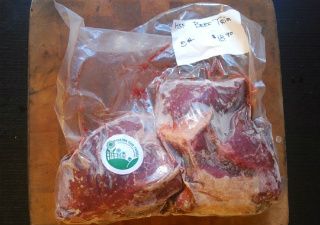
After the butcher removes the steaks, the roasts, the burger meat, the ribs, the loin, and every other cut that enjoys name recognition, he’s left with scraps of meat attached to the animal carcass. Of course, if you’re dealing with an animal as big as a cow, those “scraps” are actually quite substantial. Enter beef trim. The beef trim I purchased came in three oddly shaped slabs of good, deep-red grass-fed beef. They weren’t steaks, and they weren’t roasts, and the angles were all weird, but these were solid cohesive pieces of meat that could easily be cut up for stews, soups, ground into ground beef, or even made into jerky. It’s only trim because it wouldn’t look pretty in a display case. Other than that, it’s great meat at a great price.
I paid $3.50 a pound for grass-fed organic beef trim.
Well, that’s my haul. Between all of that, the “regular” parts described in my offal post from way back, and the post showing how to get this stuff into your diet, I’d say you have plenty of material to work with.
The beauty of buying all the odd bits is trifold. First, you’re getting a wider range of vital micronutrients, vitamins, minerals, and connective tissues that just don’t exist in large amounts in regular muscle meat. Second, it’s an affordable way to get your hands on high-quality, pastured animal products. You think you could ever find grass-fed, pastured muscle meat for a few dollars per pound? No way. And third, you are personally seeing to it that the animal in question does not go to waste. It’s not turned into poor quality pet food, nor is it discarded. It is utilized and enjoyed by a person that truly appreciates it.
Now I’d like to hear from you. What are your favorite odd bits? Are there any parts you’ve been dying to try, but haven’t found the courage to go out and find? Well, consider this post a challenge. Go branch out. Eat some weird stuff. It’s good for you and it’s delicious to boot. Make it so that it’s no longer weird, it’s no longer a special occasion, but just something you eat.